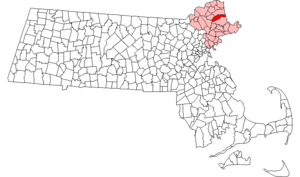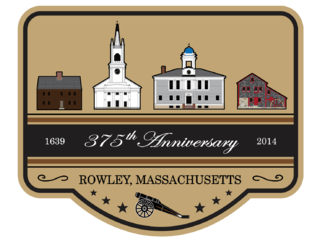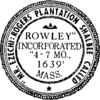Rowley, Massachusetts
| Rowley, Massachusetts | ||
|---|---|---|
| Town | ||
|
Rowley, Massachusetts celebrated its 375th anniversary in 2014 | ||
| ||
 Location in Essex County in Massachusetts | ||
| Coordinates: 42°43′00″N 70°52′45″W / 42.71667°N 70.87917°WCoordinates: 42°43′00″N 70°52′45″W / 42.71667°N 70.87917°W | ||
| Country | United States | |
| State | Massachusetts | |
| County | Essex | |
| Settled | 1638 | |
| Incorporated | 1639 | |
| Government | ||
| • Type | Open town meeting | |
| Area | ||
| • Total | 20.3 sq mi (52.7 km2) | |
| • Land | 18.2 sq mi (47.2 km2) | |
| • Water | 2.2 sq mi (5.6 km2) | |
| Elevation | 50 ft (15 m) | |
| Population (2010) | ||
| • Total | 5,856 | |
| • Density | 290/sq mi (110/km2) | |
| Time zone | Eastern (UTC-5) | |
| • Summer (DST) | Eastern (UTC-4) | |
| ZIP code | 01969 | |
| Area code(s) | 351 / 978 | |
| FIPS code | 25-58405 | |
| GNIS feature ID | 0618309 | |
| Website | Town of Rowley, Mass, Official Web Site | |
Rowley is a town in Essex County, Massachusetts, United States. The population was 5,856 at the 2010 census.[1]
Part of the town comprises the census-designated place of Rowley.
History
In spring of 1639 Rowley was originally settled as a plantation by Reverend Ezekiel Rogers, who had arrived from England on the ship John of London with approximately twenty families. The John of London also brought over the first printing press in the colonies, which was later brought to Harvard University.
The following spring, on September 4, 1639, the town was incorporated, and included portions of modern-day Byfield, Groveland, Georgetown, and Haverhill. The town was named after Rowley, East Riding of Yorkshire, where Rogers had served as pastor for twenty years before his suspension due to non-conformist Puritan beliefs. Rogers was installed as Rowley's pastor on December 3.
1643 and 1645 saw the construction of a fulling mill and grist mill, respectively. The town became known for its hemp and flax cloth, as well as cotton. In 1642, a keystone arch bridge and a dam were built on the Mill River for the fulling mill, the first such in the colonies. The bridge was the first stone arch bridge in North America, constructed entirely of hand-chiseled granite and contained no mortar. It was rebuilt in the mid-19th century. In 1669, a sawmill was established in town and is still in business today. A wagon factory was built in 1868 by Moses E. Daniels. Later, at the start of the 20th century, the town had a booming shoe industry, as well as successful boat building businesses.
Many colonial homes line Rowley's streets, mixed in with a variety of architectural styles from all throughout American history. The town common (historically called the training place), is surrounded by many simple yet graceful old homes. It was at the training place where Benedict Arnold's expedition to Quebec encamped in 1775, during the American Revolution.
Geography
According to the United States Census Bureau, the town has a total area of 20.3 square miles (52.7 km2), of which 18.2 square miles (47.1 km2) is land and 2.2 square miles (5.6 km2), or 10.56%, is water.[2] Rowley lies along the Atlantic Ocean north of Cape Ann, the mainland separated from the ocean by a small portion of Plum Island and Plum Island Sound. The island and a portion of the marshes south of Mud Creek (part of the town's northern border) are protected as part of the Parker River National Wildlife Refuge. The town has other portions which are protected, including parts of the Mill Creek Wildlife Management Area, the Georgetown-Rowley State Forest, the Willowdale State Forest, the Arthur Ewell Reservation, and the Bay Circuit Trail. Much of the eastern mainland part of town is marshy, feeding Mud Creek, Mill River and the Rowley River, which constitutes part of the town's southern border.
Rowley is located 7 miles (11 km) south of Newburyport, 16 miles (26 km) north of Salem, 17 miles (27 km) east of Lawrence, and 28 miles (45 km) northeast of Boston. It is bordered to the north by Newbury, to the northwest by Georgetown, to the west by Boxford, and to the south by Ipswich.
Interstate 95 passes through the western end of town, with the nearest exits being in Georgetown and Boxford. U.S. Route 1, known as the Newburyport Turnpike in the area, passes near the geographic center of town, and Massachusetts Route 1A passes through the eastern part of town, through the town center. All three roads are connected by Massachusetts Route 133, which passes from west to east through the town, becoming coextensive with Route 1A just north of the Ipswich town line and heading south with it.
Rowley is one of the stations along the Newburyport/Rockport Line of the MBTA Commuter Rail, providing service between Newburyport to the North Shore and Boston's North Station. The nearest national air service can be found at Boston's Logan International Airport, though Plum Island Airport, a small general aviation airport, is located in neighboring Newburyport.
Demographics
| Historical population | ||
|---|---|---|
| Year | Pop. | ±% |
| 1850 | 1,075 | — |
| 1860 | 1,278 | +18.9% |
| 1870 | 1,157 | −9.5% |
| 1880 | 1,201 | +3.8% |
| 1890 | 1,248 | +3.9% |
| 1900 | 1,391 | +11.5% |
| 1910 | 1,368 | −1.7% |
| 1920 | 1,249 | −8.7% |
| 1930 | 1,356 | +8.6% |
| 1940 | 1,533 | +13.1% |
| 1950 | 1,768 | +15.3% |
| 1960 | 2,783 | +57.4% |
| 1970 | 3,040 | +9.2% |
| 1980 | 3,867 | +27.2% |
| 1990 | 4,452 | +15.1% |
| 2000 | 5,500 | +23.5% |
| 2010 | 5,856 | +6.5% |
| * = population estimate. Source: United States Census records and Population Estimates Program data.[3][4][5][6][7][8][9][10][11][12] | ||
As of the census[13] of 2000, there were 5,500 people, 1,958 households, and 1,468 families residing in the town. The population density was 293.8 people per square mile (113.4/km²). There were 2,004 housing units at an average density of 107.1 per square mile (41.3/km²). The racial makeup of the town was 98.38% White, 0.24% Black or African American, 0.25% Native American, 0.45% Asian, 0.27% from other races, and 0.40% from two or more races. Hispanic or Latino of any race were 0.85% of the population.
There were 1,958 households out of which 39.0% had children under the age of 18 living with them, 64.5% were married couples living together, 7.7% had a female householder with no husband present, and 25.0% were non-families. 20.1% of all households were made up of individuals and 7.3% had someone living alone who was 65 years of age or older. The average household size was 2.77 and the average family size was 3.23.
In the town the population was spread out with 28.0% under the age of 18, 5.9% from 18 to 24, 32.5% from 25 to 44, 24.3% from 45 to 64, and 9.4% who were 65 years of age or older. The median age was 38 years. For every 100 females there were 97.8 males. For every 100 females age 18 and over, there were 92.1 males.
The median income for a household in the town was $62,130, and the median income for a family was $75,527. Males had a median income of $49,970 versus $32,500 for females. The per capita income for the town was $27,413. About 3.3% of families and 4.1% of the population were below the poverty line, including 5.8% of those under age 18 and 11.4% of those age 65 or over.
Literature
Rowley is the town that the protagonist flees to from fictional Innsmouth in the H. P. Lovecraft short story "The Shadow Over Innsmouth". In the story, Innsmouth is located to the southeast of Rowley.
Notable people
- Jeremiah Chaplin, 1st President of Colby College
- Bruce Kimball, retired NFL football player for the Washington Redskins and New York Giants
- Josiah Little Pickard, educator
- Nathaniel Prime, merchant and banker based in New York City, pioneer in specializing in trading securities
- Margaret Scott, hanged during the Salem witch trial
See also
References
- ↑ "Profile of General Population and Housing Characteristics: 2010 Demographic Profile Data (DP-1): Rowley town, Essex County, Massachusetts". U.S. Census Bureau, American Factfinder. Retrieved September 5, 2012.
- ↑ "Geographic Identifiers: 2010 Demographic Profile Data (G001): Rowley town, Essex County, Massachusetts". U.S. Census Bureau, American Factfinder. Retrieved September 5, 2012.
- ↑ "TOTAL POPULATION (P1), 2010 Census Summary File 1". American FactFinder, All County Subdivisions within Massachusetts. United States Census Bureau. 2010.
- ↑ "Massachusetts by Place and County Subdivision - GCT-T1. Population Estimates". United States Census Bureau. Retrieved July 12, 2011.
- ↑ "1990 Census of Population, General Population Characteristics: Massachusetts" (PDF). US Census Bureau. December 1990. Table 76: General Characteristics of Persons, Households, and Families: 1990. 1990 CP-1-23. Retrieved July 12, 2011.
- ↑ "1980 Census of the Population, Number of Inhabitants: Massachusetts" (PDF). US Census Bureau. December 1981. Table 4. Populations of County Subdivisions: 1960 to 1980. PC80-1-A23. Retrieved July 12, 2011.
- ↑ "1950 Census of Population" (PDF). Bureau of the Census. 1952. Section 6, Pages 21-10 and 21-11, Massachusetts Table 6. Population of Counties by Minor Civil Divisions: 1930 to 1950. Retrieved July 12, 2011.
- ↑ "1920 Census of Population" (PDF). Bureau of the Census. Number of Inhabitants, by Counties and Minor Civil Divisions. Pages 21-5 through 21-7. Massachusetts Table 2. Population of Counties by Minor Civil Divisions: 1920, 1910, and 1920. Retrieved July 12, 2011.
- ↑ "1890 Census of the Population" (PDF). Department of the Interior, Census Office. Pages 179 through 182. Massachusetts Table 5. Population of States and Territories by Minor Civil Divisions: 1880 and 1890. Retrieved July 12, 2011.
- ↑ "1870 Census of the Population" (PDF). Department of the Interior, Census Office. 1872. Pages 217 through 220. Table IX. Population of Minor Civil Divisions, &c. Massachusetts. Retrieved July 12, 2011.
- ↑ "1860 Census" (PDF). Department of the Interior, Census Office. 1864. Pages 220 through 226. State of Massachusetts Table No. 3. Populations of Cities, Towns, &c. Retrieved July 12, 2011.
- ↑ "1850 Census" (PDF). Department of the Interior, Census Office. 1854. Pages 338 through 393. Populations of Cities, Towns, &c. Retrieved July 12, 2011.
- ↑ "American FactFinder". United States Census Bureau. Retrieved 2008-01-31.
External links
| Wikimedia Commons has media related to Rowley, Massachusetts. |
- Town of Rowley official website
- Chaplin, Joseph. "A Map of Rowley". Essex County 1795. Registry of Deeds Southern Essex District. Retrieved 31 July 2010.
- Anderson, Philander. "Map of Rowley". Essex County 1830. Registry of Deeds Southern Essex District. Retrieved 31 July 2010.
- D.G. Beers & Co. "Rowley". Essex County 1872. Registry of Deeds Southern Essex District. Retrieved 31 July 2010.
- Walker, George. 1884 Atlas of Essex County. 1884 Map of Rowley. Published 1884 by George Walker.
- Vital Records of Rowley to 1849. Originally published by the Essex Institute. Transcribed and put online by John Slaughter and Jodi Salero 2007.


